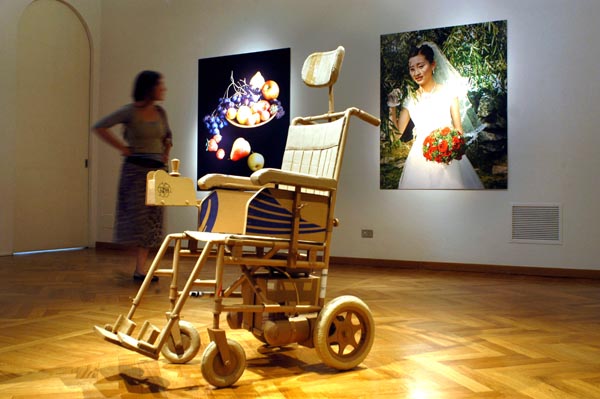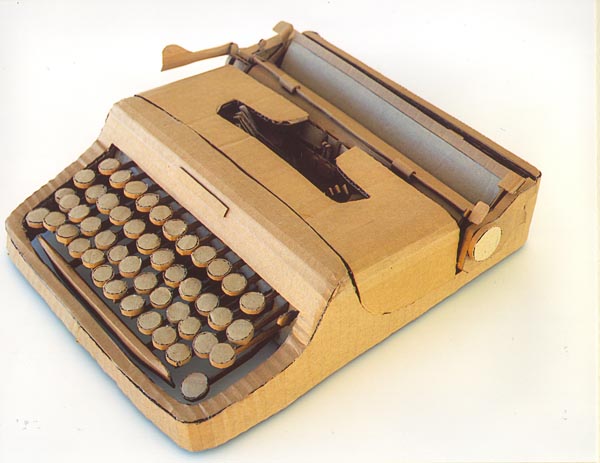A few weeks ago I gave some shine to Chris Gilmour’s life-size cardboard and glue sculptures. The detail is meticulous. He’s had me obsessed since I came across his work. It’s the kinda stuff that makes you stop and appreciate everyday objects that you probably otherwise dismiss and take for granted on a daily basis.
Turns out he’s having his second exhibition in NYC at Freight + Volume (542 West 24th Street, NYC). The shows runs September 12 – October 11. Definitely LIAS recommended.
Also have an interview with Chris about his work… you can read what he had to say and see more work after the jump.
Your work ranges from objects from daily life, to small models of religious architecture, in a way “desecrated” by the graphics of the packaging, to a piano hanging from the ceiling in the last solo show and objects from pop culture… how do you choose the things you portray?
There has been a progression in the choice of objects portrayed, which go from smaller domestic items (like the moka or the typewriter) to objects which are larger and belong to a broader cultural context (the Fiat 500, the Lambretta). However, the reason for the choice of objects has always been pretty much the same- they call up memories and emotions connected to our experience of these (everyday) things. Since this is both a visual and conceptual work I choose objects for their visual appeal and cultural resonance, but I also usually choose objects which imply an action or interaction of some sort. The interaction of the viewer with the works seems to function as a kind of short circuit between an implied action and the impossibility of performing it: you want to open the car door, or turn the wheel on the bike, but of course you can’t. I think this immediacy is important to enter the work, to grab the viewer.
What relationship is there between the artwork and the type of packaging you use? In the earlier works you were using plain cardboard, but in the recent works you can see the graphics and printing on the boxes…
Earlier works were made with very clean cardboard because I was aiming at a hyper-realistic effect which showed the material “at its best”, or rather seemed to do something impossible with it, making a perfect representation- indeed, many people assumed that the works were real objects that had been painted or covered in paper. The works I am producing now are made from cardboard boxes which are still found on the street, but which show all the printing, tape, labels etc…
I like the idea of concentrating on the material in its “natural state” and playing with the idea of these beautiful objects represented with a material from the waste basket. I guess it’s about trying to be as honest as possible with the material- I don’t want it to get too clean, so you can’t see what it really is. I think it gives another dimension to the work to use scrap cardboard packaging which has been thrown away after the coveted objects it contained have been removed.
You often use pre-existing materials, giving them a “new life”… what do you think of the connection between art and “recycling”? Could your artwork be understood as a new understanding of materials which we normally tend to discard and throw away?
Maybe it’s a way of re-appropriating or taking control of the things around us, which if you live in a city are pretty much all man-made. I think the use of re-cycled or found materials is brought about by our proximity to these things and their familiarity. One of the reasons I use cardboard is because it’s so easy to find- we have an immediate access to these “re-cycled” materials in a way that could never be possible with bronze or marble. It is also free of the historical and cultural weight of those classical sculptural materials, and can offer new readings of the work. By using a material which everybody knows and understands, I can build on the pre-existing associations to develop ideas and ways of reading the work. It’s a way of creating a language which is understood by many.
Which do you think is the most significant piece you have made and why?
A key piece is the wheelchair, as this marks the change from earlier works with human figures to the current work without. I used the figures to tell a story about the object portrayed, but the more I worked on the objects the more I realised that the interaction between the object and the viewer was a powerful element- the viewer brings his own story to the object, and doesn’t need a kind of theatrical set to explain the situation. People often have a very immediate reaction to my works- they try to open the car door, or type on the typewriter and I like the game of contrasts-real/not-real, functional/non-functional, heavy/light- and the sensation that causes. I think that the viewer projects himself into the work, and indeed the reaction to the wheelchair was different- it’s a slightly disquieting object and no one wanted to touch it.
What kind of consumer are you? How much do you feel you are influenced by packaging, which you also use in your artwork?
I do tend to notice packaging, it’s something I find fascinating. I guess on a daily basis I just buy the same stuff and don’t think about it too much, but I needed lots of different packets to make the small churches, so we bought a lot of things just because of the packaging. Buying one of every item in the supermarket was fun but it did leave us with a cupboard full of food we didn’t much like and couldn’t tell what it was because I’d taken the wrapping off it…
Which artists have influenced you, who has been an inspiration for you?
I really like other sculptors who seem to share my interest in materials. I get the impression that their ideas come from playing about with things. For example, artists I always love to see for their approach to materials are Anish Kapoor, Andy Goldsworthy, Tom Friedman, and Bill Woodrow – Goldsworthy and Kapoor make sculptures with an incredible attention to the nature of the materials they use, and, although the appearance of the work is completely different, I think Friedman and Woodrow have a similar sensibility. It’s like the classical ideas of sculpture about the “soul” of the material, but instead of a block of marble it is being applied to leaves of washing machines…
You are from Great Britain, but you live in Italy: is your work seen differently in the two countries?
The first big piece I ever made was a cardboard cow, “to sell to farmers in order to replace the cattle destroyed by BSE, so that the fields don’t look empty”. This had a great impact and was covered in national newspapers, magazines and on the radio. Unfortunately the farmers took offence and I had to flee to Italy for safety: even now I can only go back in disguise… actually that’s a lie (the bit about the farmers), but I do work principally in Italy, mainland Europe and America and don’t often go to the UK. However, I think the public perception of the work is similar in different countries, the reaction to the objects is the same, even though the memories or cultural significance must be different. Hopefully this means these objects communicate to different nationalities and cultures, perhaps because packaging is a kind of common denominator.
What was the thinking behind your last solo show?
One of the reasons I am attracted by cardboard is that, although it can be an expensive material, people fail to notice it and just throw it away when buying an object, often slightly irritated at the thought of having to dispose of it. There is a widespread idea of having to leave our mark, of expressing our personality by buying this or that object that will best convey our originality. Almost as if the consumer society had transformed even our personalities into something you can buy. We buy more and more things, which are greener than our neighbour’s, more loaded with gadgets. The show is about that, about objects that we choose to represent our special (agent) nature, about the roles that we like to imagine playing out in our minds, about goods and their place in our unconscious.




